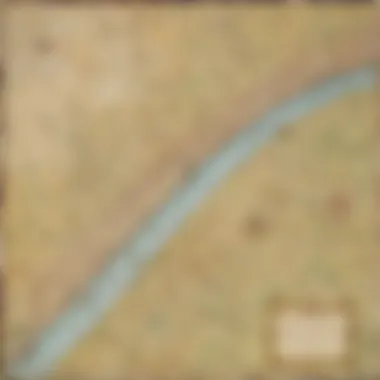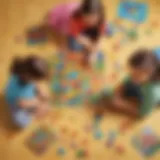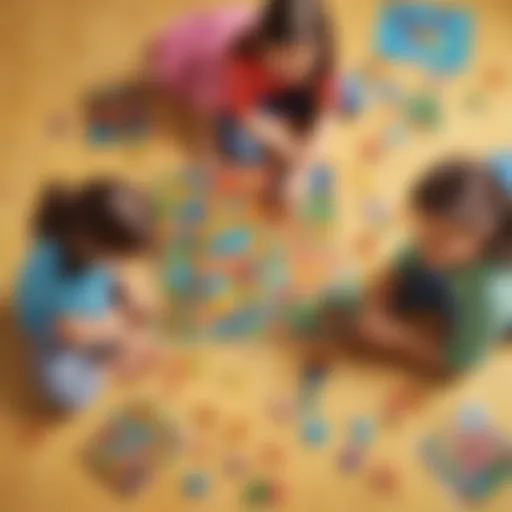Understanding the Mile: A Comprehensive Guide


Intro
When we talk about distance, the mile stands out as a traditional unit that has shaped journeying and exploration throughout history. Imagine walking a mile: it's about 2,000 steps for most people. This measure has rich roots, revealing insights into human progress and culture. In the coming sections, we will unearth the mile's significance, how it converts into metric measurements, and its varied uses in our daily lives. Let’s embark on this enlightening adventure together, where numbers come to life!
Creative Activities
Understanding a mile can be fun beyond just numbers. Here are creative activities that not only enhance appreciation for this measure but also engage the little minds in learning!
Craft Ideas
Kids love crafts, so why not create something meaningful?
- Mile Marker Craft: Use cardboard to make your own ‘mile markers’ that can be placed around the home or garden. Coloring each with vibrant colors makes it exciting!
- Step Tracker Chart: Create a chart to track how many steps you and your child take each day. Use stickers for every 100 steps to visualize distance covered together.
Step-by-Step Guides
For both crafts mentioned, here’s what you need and how to make them:
- Mile Marker Craft:
- Step Tracker Chart:
- Gather materials: cardboard, scissors, markers, and glue.
- Cut the cardboard into rectangular shapes.
- Decorate one side with numbers and designs.
- Set them up in your garden to mark distances!
- Take a large piece of paper.
- Draw a grid with columns representing each day.
- Use a line for the steps taken daily.
- Reward your child with a sticker or a star when they reach a mile!
Educational Value
These activities develop not only creativity but also promote understanding of measurements, spatial awareness, and teamwork. They get kids moving, which enhances their physical health, too.
Fun Quizzes
To reinforce what we’ve learned about miles, quizzes can be a delightful way to assess knowledge while promoting engagement!
Quiz Topics
Here are some fun topics for quizzes:
- Conversion Challenges: How many kilometers are in a mile?
- Historical Facts: When was the mile first used?
- Distance Recognition: Identify places that are a mile apart!
Question Types
Utilize different questions such as:
- Multiple-choice questions for selecting the correct answers.
- Fill-in-the-blank queries for recalling specific information.
- True or false statements for quick decision-making.
Knowledge Reinforcement
Quizzes not only assess comprehension but also strengthen memory on the topic! They transform learning into a game-like atmosphere, making information stick.
Fact-Based Articles
Children thrive on interesting facts, and here are ways to explore information about miles:
Topics
The articles can span a range of topics, such as:
- The history of the mile and its evolution.
- Comparison with other units of measure, like the kilometer.
Engaging Content
These articles present information in a narrative fashion, with colorful illustrations and relatable examples, making them digestible and enjoyable for all.
The Concept of a Mile


When we think about distances, the mile stands out as a common point of reference in everyday life. It's not just a number; it's a concept tightly woven into the fabric of society, influencing how we perceive space and travel. Understanding the mile is essential for grasping distances in various contexts, whether you're planning a road trip or trying to improve running times. This section focuses on the mile’s significance and its role in our daily interactions with distance.
A mile might seem straightforward, but it carries deeper implications. For students and parents alike, knowing how far a mile is can help in practical situations, such as calculating travel times or comparing different distances. Also, in physical education, understanding how one mile translates into laps around a track or distances run can help children visualize their athletic goals.
"Distance is a measure of how far we can go, and a mile often defines the limits of our daily journeys."
Definition of a Mile
A mile is officially defined as equal to 5,280 feet or 1,760 yards. It’s a unit commonly used in the United States and a few other countries. Unlike some other measurement systems that can become confusing, the mile has a single, clear definition. In practical use, this measurement becomes invaluable in many areas:
- Traffic: Road signs often mark distances in miles, helping drivers gauge how long it will take to reach their destination.
- Athletics: Races, particularly in the U.S., often feature the mile as a standard distance for competitions.
Understanding what a mile represents—not just in terms of feet and yards but in real-life applications—provides a solid foundation for learning about measurements in general. The mile is familiar to many; hence lessons about it resonate well, making it less tedious. It's a unit that's been around for some time, deeply embedded in various forms of communication and activity.
Historical Origins
The concept of a mile has roots tracing back to ancient civilizations. The word "mile" itself comes from the Latin term "mille passus," meaning "a thousand paces." Back in Roman times, this was the distance a soldier would cover in a thousand steps. The Romans used it as a way to measure land and distances while expanding their empire. The practicalities of a mile were particularly useful in transport and trade.
As time marched on, various cultures had their versions of the mile. Over the years, as systems evolved, the mile became standardized in the United Kingdom and later the United States, creating a consistent unit.
In many ways, understanding the historical context enriches the meaning of a mile today. It reminds us of our journey from ancient steps to modern roadways, linking us back to our shared human experience.
Measurement Systems
Measurement systems play a key role in understanding the concept of distance, especially when discussing a unit like a mile. With different systems in use around the world, it is crucial for young learners and their caregivers to grasp these distinctions. This knowledge fosters not just academic learning but also practical understanding, facilitating easier navigation of everyday life.
One might wonder why measurement systems are so significant. Firstly, they provide a standard that helps everyone communicate distance clearly. Imagine if one person measured distances in miles while another used kilometers—confusion would reign. Establishing a common language for distance improves understanding and reduces errors, which is essential whether you’re planning a family road trip or measuring a backyard for a new swing set.
Imperial vs. Metric
The Imperial and Metric systems are the two primary frameworks we often hear about when discussing measurements. In the United States, the Imperial system is common, whereas most other countries utilize the Metric system. Understanding the differences between these systems can help clarify why a mile might seem more familiar to some people than to others.
The Imperial system consists of units such as inches, feet, yards, and miles. For example, a mile is equivalent to 5,280 feet. In contrast, the Metric system is based on decimal units, making it easier to convert between different measurements. A kilometer, for example, is 1,000 meters. The simplicity of the Metric system allows for straightforward calculation and conversion.
Consider this: When traveling, knowing both systems can prevent bewilderment when unfamiliar signs indicate distance.
Understanding Units of Distance
Units of distance serve as the framework upon which we build our understanding of measurement. In essence, they act as the stepping stones for comparing various distances. For our budding learners, it’s essential to familiarize them with several units beyond just the mile. Here are some units you might encounter:
- Feet: Commonly used for short distances.
- Yards: Often used in sports and landscaping.
- Kilometers: Standard in most countries for longer distances.
- Nautical miles: Used in maritime and air navigation.
To put it into perspective, think about a soccer field: it’s usually about 100 yards long. That’s approximately one-tenth of a mile!
Understanding these units can empower anyone, especially children, to better assess distances in both their local communities and when traveling far from home. When they know how to interpret and convert these units, a simple journey transforms into an entire realm of possibilities, enriching their daily experiences.
"A mile may be just a number, but understanding it can open up the entire world."
Giving children the tools to understand various measurement systems will not only aid academic performance but also empower them to navigate life more effectively.
Conversion Factors
When we talk about distances, knowing how to convert between different units is like having a Swiss Army knife in your pocket; it’s versatile and handy. This section digs into conversion factors, which are essential in bridging the gap between miles and other units like kilometers, feet, and yards. Understanding these factors isn’t just for math whizzes; it benefits everyone who interacts with distance in daily life. For instance, whether it’s planning a road trip across country or measuring out a running track, conversion factors help make sense of the numbers we encounter.
Miles to Kilometers
Mile to Kilometer Conversion Formula
At its core, the mile to kilometer conversion formula is straightforward. To convert miles into kilometers, you typically multiply the number of miles by 1.60934. That’s right! Just remember this little nugget: 1 mile is equal to about 1.6 kilometers. This conversion is not merely digits on a page; it's a practical tool that helps travelers, athletes, and even children understand their world better.
The excellent characteristic of this formula is its simplicity. It can be applied effortlessly by anyone, from a student trying to complete a homework problem to an adult navigating a fitness challenge. Moreover, it provides a quick way to convert distances without the need for fancy tools or gadgets.
However, one downside is that without a calculator, you might have to do some mental gymnastics to get to the exact conversion, but that’s half the fun of learning!
Practical Examples


Real-life examples can clarify how we use miles and kilometers day-to-day. Suppose you’ve run 3 miles on a treadmill. Using our earlier conversion, that’s roughly 4.8 kilometers. Seeing this number allows you to compare your workout more easily with data from friends or those in countries where kilometers are the norm.
The significance of these practical examples is that they enable learners, especially children, to visualize and internalize the abstract concept of distance. This technique enhances comprehension because it creates a connection between numbers and the tangible world. The unique feature here is relatability; by using familiar scenarios such as running or biking, kids can make sense of the conversion.
Though, one thing to be cautious of is that constantly converting can sometimes lead to confusion, especially if the child is not deeply familiar with the metric system yet.
Miles to Feet and Yards
Understanding Larger Units
Understanding larger units like feet and yards is vital, especially in countries like the United States, where this system is more common. A mile is equivalent to 5,280 feet or 1,760 yards. Imagine yourself standing in a field and looking towards one mile—this simple visualization makes these large numbers feel more manageable.
A standout quality of knowing these conversions is that it places the concept of a mile within the context of everyday objects and activities. For example, if a football field is 300 feet long, you can easily tell just how many fields there are in a mile—over 17! It gives learners a more tangible grasp of distances.
Nonetheless, one caveat to keep in mind is that the sheer volume of feet and yards within a mile might be overwhelming to younger students, making them lose sight of the bigger picture.
Useful Conversion Tips
When converting, a few tips can work as saving graces. For instance, when doing these conversions, it’s beneficial to round numbers to simplify calculations. If you’re in a rush, remember that one mile is roughly 5,000 feet. This quick trick can help during sports events or casual conversations about distance, allowing less worrying about digits and more focus on the activity.
Another handy tip is using apps or websites that can instantly convert between units. Kids can even use basic calculators to refine their skills, gradually replacing rough estimates with precise numbers.
The key advantage of these tips lies in making the information accessible. Even people who aren’t mathematically inclined will find approaches straightforward and manageable. This bridges the gap for families who may not have frequent conversations about distances and measurements, ensuring that every interaction becomes a learning opportunity.
"One mile is just a number unless you understand what it means in your own context."
In summary, conversion factors serve as essential tools that aid us in navigating the numerous ways we represent distance. They empower students, parents, and teachers alike by fostering understanding and making real-world applications clearer.
Practical Applications
Understanding the practical applications of a mile is crucial because it gives this unit of distance real-world significance. Whether running laps in a park or planning a road trip, knowing how a mile functions in daily life can simplify matters. Most importantly, it helps in building a strong foundation for further learning about measurements and their relevance.
When children engage with the concept of a mile through practical scenarios, they develop a grasp of distances that extends beyond textbooks. This experiential learning creates context and relevance, turning abstract numbers into tangible experiences.
Real Life Examples of One Mile
Distance in Running Events
Off the track, the mile serves as a fundamental distance in running events. Popularized in professional events like the Mile Run, it acts as a benchmark for fitness enthusiasts. Notably, this distance is appealing as it’s long enough to challenge a runner but short enough for newcomers to feel motivated. The unique feature here lies in the endurance aspect; it’s the test of stamina over speed. That makes it an attractive choice for fitness events in elementary schools too.
In many races, you’ll find that participants enjoy the camaraderie and the sense of achievement—a one-mile run feels significant, even if it’s just a warm-up. The effort also encourages children to set personal goals, fostering motivation and character development. The disadvantages, however, could include the potential for discouragement from those who may find long distances intimidating. So, organizers make sure to create a supportive atmosphere.
Map Distances
Now let’s turn to map distances, which often stir curiosity. In learning environments, when kids look at maps showing distances in miles, it fosters orientation skills. Understanding that a mile on a map translates to real-world distance can make geography come alive.
A fascinating aspect is how visualizing a mile can help them relate distances to journeys they already know. For instance, if the store is a mile away, they can visualize walking there, which brings the concept home. This enhances comprehension of distances rather than seeing them as just numbers.
However, one must also consider that on a map, the accuracy of the mile can vary based on scale. It’s important to teach them how to read these scales correctly. Missing this piece might lead to miscalculations and longer-than-anticipated trips.
Significance in Transportation
Road Trip Distances
Road trips are a classic American pastime, and miles play a starring role in the planning of these adventures. Families often plot their journeys based on how many miles to their next destination. This practical understanding helps them gauge travel times and plan rest stops effectively.
Importantly, when children learn about miles in the context of road trips, it transforms the lesson into an enjoyable experience. They can participate in planning and estimating travel time, making calculations as enjoyable as counting sheep for sleep!
Of course, one downside could be that estimating road trip times may not always account for traffic or road conditions. Making children aware of this is essential; it prepares them for the unpredictable nature of traveling.
Navigation Systems
Finally, let’s discuss navigation systems—think Google Maps or Waze. These modern tools use miles to help users find their way, making understanding this measurement even more relevant. Knowing that those little numbers reflect actual distances allows for better route planning.


One standout trait of these systems is real-time updates, guiding users to avoid congestion. They often feature milestones in miles, such as "5 miles to exit"—this practical aspect can make trips less stressful with the right knowledge. However, reliance on electronic navigation can sometimes overshadow map reading skills. Ensuring children learn both aids in developing a more rounded understanding of navigation as a whole.
Ultimately, understanding these practical applications of a mile—whether through running, maps, or navigating road trips—enriches knowledge for kids. It is about taking the concept beyond mere numbers, allowing them see its impact on their lives.
Knowing how to measure distances helps in both daily life and pursuing further studies in various subjects.
Cultural Impacts of a Mile
The mile, while simply a unit of measurement, has burrowed deep into the cultural fabric of many societies. It’s more than just a distance; it possesses significance in various aspects of life, especially in sports, literature, and expressions. Understanding these cultural impacts aids in appreciating not just the measurement itself, but the broader implications it holds across different fields and contexts.
Mile in Sports and Competitions
Classic Races
In the realm of athletics, classic races prominently feature the mile as a significant benchmark. Events such as the Mile Run have been a staple of track and field competitions. Why does the classic mile resonate so much? It often symbolizes endurance and speed. Athletes train to master this distance, pushing their limits and achieving personal bests.
The unique feature of classic races centered around a mile is the sense of drama. The crowd becomes electric, cheering as runners sprint towards the finish line. This aspect of competition brings communities together, allowing spectators to bond over shared excitement. Classic mile races also come with hidden advantages. They attract a wide range of participants, from elite athletes to casual runners, making the competition both prestigious and accessible.
Marathon Distances
Whereas the standard marathon covers 26.2 miles, it roots in the concept of the mile. Specifically, the marathon often incorporates mile markers, providing runners with tangible goals throughout the grueling distance. This organizational element helps runners gauge their stamina and pace, which can be crucial for completing such a taxing event.
The significance of mile markers in marathon distances is heartening. Each mile brings the runner one step closer to the finish line, providing mental encouragement along the way. Additionally, using miles in this context appeals to many, as it resonates with the experiences of those who train and compete across the globe. However, marathon distances are demanding and can be intimidating for newcomers. It requires a commitment and understanding the body’s limits, making training for such a race a serious undertaking.
Mile in Literature and Expressions
Famous Quotes
The term "mile" pops up frequently in famous quotes and speeches. Take the expression, "A mile in someone else's shoes." This kind of saying reflects the idea of empathy and understanding, encouraging listeners to consider perspectives beyond their own. Such quotes are powerful, encapsulating deep life lessons in simple language.
What makes quotes involving the mile particularly beneficial is their ability to inspire. They connect common experiences with a broader meaning, providing a roadmap for personal growth. However, while they’re memorable, not all interpretations of these quotes are the same, leaving room for debate and discussion.
Literary References
In literature, the mile serves as a powerful symbol, representing journeys or challenges faced by characters. Classic novels may feature miles both as physical distances and metaphorical challenges. For instance, an author might write about traveling a mile through a harsh landscape, illustrating the struggle against adversity.
Fictional references such as this are critical. They share lessons about perseverance and resilience in facing life's obstacles. Literature uses these symbols to communicate deeper messages, though some might argue that a focus on physical distances can overshadow the emotional journeys characters undertake. Still, these narratives often leave a lasting impact, making the mile a recurrent motif that enriches storytelling.
"Every step of a mile counts when you’re moving toward your goals."
Understanding the cultural impacts surrounding the mile broadens our appreciation of this unit of distance. It’s woven into the rhythm of sports, echoed in the wisdom of literature, and part of the human experience as we engage with the world around us.
Engaging with the Concept of a Mile
Interactive Activities
Interactive activities can be a fantastic way to solidify this understanding, making the concept of a mile not just an abstract number, but something that feels more real and accessible to young learners. Through engaging challenges and games, children can better grasp not just what a mile is, but how it feels like when put into various contexts.
Distance Estimation Games
Distance estimation games encourage kids to use their imagination and existing knowledge to guess how far a mile is in terms they can visualize. One key characteristic of these games is that they often involve familiar locations or distances:
- Local Landmarks: Ask children to estimate how many houses, schoolyards, or parks equal a mile. This bridges their everyday observations to a measurable unit, creating a tactile relationship.
- Physical Activity: Children can run, walk, or bike estimated distances to measure and compare with a mile. It’s a fun way for them to experience the concept physically.
This method is beneficial as it fosters not just cognitive understanding but also physical connection with the distance. However, a challenge arises in the variance of individual perceptions. A child’s estimations may vastly differ based on their unique experiences or the context provided.
Measurement Challenges
Measurement challenges take a more structured approach to understanding the mile. In this activity, children can engage in practical tasks that require them to work through how far a mile really feels in the day-to-day world. For example:
- Mapping Activities: Young learners can use maps to plot out a mile, measuring distances to visualize it better. This activity promotes the understanding of distance not just linearly but spatially.
- Rulers and Measuring Tape: By using common measuring tools to measure out a mile in smaller increments, it also teaches kids critical thinking and basic measuring skills.
The key characteristic of these challenges is their focus on precision and tangible results. It's a popular choice as it connects theoretical knowledge to practical application. However, some children might find this exercise frustrating if they struggle with measuring tools or concepts of scale.
Fun Facts about Miles
Engaging with the concept of a mile also includes learning fun trivia that can pique interest and spark conversation among kids. Here are some notable facts that might entertain and educate:
- A mile contains 5,280 feet. Picture that! That’s like stacking more than five thousand school rulers end to end.
- The longest annual race held is a mile long, known as the Mile in various athletic competitions, showing just how significant this measure is in the world of sports.
- Did you know that in the UK, there’s a historical mile, known as a Scottish mile, which is slightly longer than the standard mile?
These interesting nuggets about miles can foster discussions and lead to further inquiries, making the learning process vibrant and engaging. The idea is to cultivate an enjoyable experience that blends education with interaction, enriching children’s grasp of the mile in dynamic ways.







